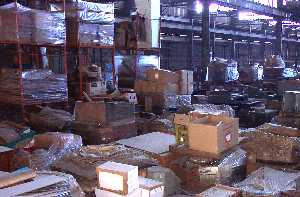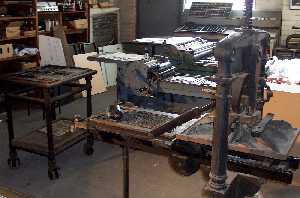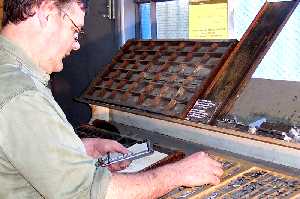![Melbourne Museum of Printing [36pt Old English]](../../-pix/mmolde36.gif)

P.O. BOX 555, FOOTSCRAY 3011 - - - - - - - - - - - - - (03)9689 7555
 OUR WEB PAGE: www.BalanceResearch.com/museum/
OUR WEB PAGE: www.BalanceResearch.com/museum/
A GREAT NEW MUSEUM, OPENING 2003
| Education | Tourism | Access Studio for Artists |
Volunteering | Heritage |
This is the world’s largest and most comprehensive museum of
print-related machinery and artefacts.
The Museum of Printing is establishing a new home in central
Footscray, to be opened in 2003, where about 10% of our collection
will be in use for education, printmaking and public programs. The
other 90% is in our storage facility in Maribyrnong and is available
for research, exhibit changeover, re-enactment events and support of
other museums.
|
We had to leave our previous site, the old cotton mills, in 1998, and
all programs had to close. Fortunately we were able to protect our
collection in temporary storage. Our present storage arrangements are
satisfactory but there is still a degree of jeopardy because the Museum
is unable to pay the rent for storage until programs are in full
swing.
The Museum will soon be offering again its unique services to students
(at all levels), printmakers and graphic artists, tourists, school and
citizens groups, researchers and the general public. We will continue
our support of other museums and similar bodies needing advice, parts
and supplies unique to traditional printing.
The students we serve with formal classes are those interested in
Graphic Design, Typography, History, Society and the Environment, and
Technology. These classes will make up more than half of our activity.
The research opportunities will appeal to academics in History areas
(Design, Industry, Society) as well as technical areas.
Our collection includes a substantial number of print-related artefacts
retrieved from the last printeries to change technology or close down
in the 1970’s, 80’s and 90’s. There is very little of this material
left in industry, and it is believed that there are few collections of
this class in the world. |

ENLARGEMENT AND DESCRIPTION
Artefacts and documents by the thousand, boxed and palletted. Printing
heritage items waiting in the store for their fate. Will they be saved
for research?
|
Our Collection: machinery and equipment, artefacts, books,
documents . . .
- We have around 200 machines of many kinds relating to printing
and typesetting, including paper cutting and other finishing processes.
We have lots of interesting, purpose-built furniture like type cabinets
and many kinds of non-mechanical equipment including hand tools.
- There are thousands of “saved jobs” (typesettings and blocks)
showing the kind of work carried out by the dozens of Melbourne
printers represented in this unique collection.
- Our library has thousands of books selected not for who wrote them
but who printed them, and how they were printed. Many closed printers
were kind enough to give us some work records: quotations, invoices,
proofs, samples, order books, etc..
- We also have collections of office equipment including early
typewriters and computers, and everything which made up a printing
business – even the billiard table!
- Our collection is large enough to show our visitors what a real
printing works was like, in size, complexity and atmosphere. The larger
places had ten, fifty or eighty Linotype (typesetting) machines, for
example. We can mount a display at least to a medium size of composing
room. This capability is unique in the world.
|

ENLARGEMENT AND DESCRIPTION
Printing Presses in our Studio. |
Our Programs: education, artist studio, volunteering, research,
public access . . .
Our Graphic Students’ Workshop was running on a pilot basis when we
had to close, and will be the first to start again. Aimed at secondary
college students taking visual design or typography, this five-hour
workshop shows the principles of printing, the historic development,
and the links between today’s text software and the principles worked
out by craftsmen over the centuries. Teachers at TAFE and university
level also found this relevant.
|
The Access Studio has attracted many artists, writers and others.
They are shown how typesetting and printing is done by hand and can
print a poem, a poster, or a whole book. We have many beautiful
examples of their work in our “Gallery of Hand-made Prints”. A number
of artists are just waiting for us to re-open because there is no
similar facility in Australia, and very few in the world. We expect
demand for this facility from overseas artists as well.
Our artefacts, like “saved jobs”, and documents, are a rich source of
information about the printing industry and the customers it served
over past decades. Researchers have shown an interest in using this
resource.
The general admission (normal museum entry) program will kick off a
year or so after the others. It should attract an interesting
cross-section of locals and visitors as well as being a great place for
citizens’ clubs and schools groups.
Film makers have also made use of the Museum’s collection, both on-site
and off-site. We supplied presses etc and expert advice for
Pozieres and My Brother Jack.
A museum of this kind depends on a healthy roster of volunteers. The
community in Footscray and greater Melbourne will be glad of the chance
to join our volunteers, learn about the collection and show people
around and help with upkeep. |

ENLARGEMENT AND DESCRIPTION
Printmaker John Ryrie typesetting in the Museum's Access Studio
|
WHERE TO FROM HERE?
The Museum is currently negotiating with a number of authorities,
companies and foundations for assistance with the cost of our store.
Our programs will cover this and all other costs when fully
operational, but until then the Museum needs support if we are not to
lose the bulk of our unique, world-class collection. If you can help us
negotiate, please contact our Director.
Michael Isaachsen, HONORARY CURATOR/DIRECTOR 28 MARCH 2003
|




